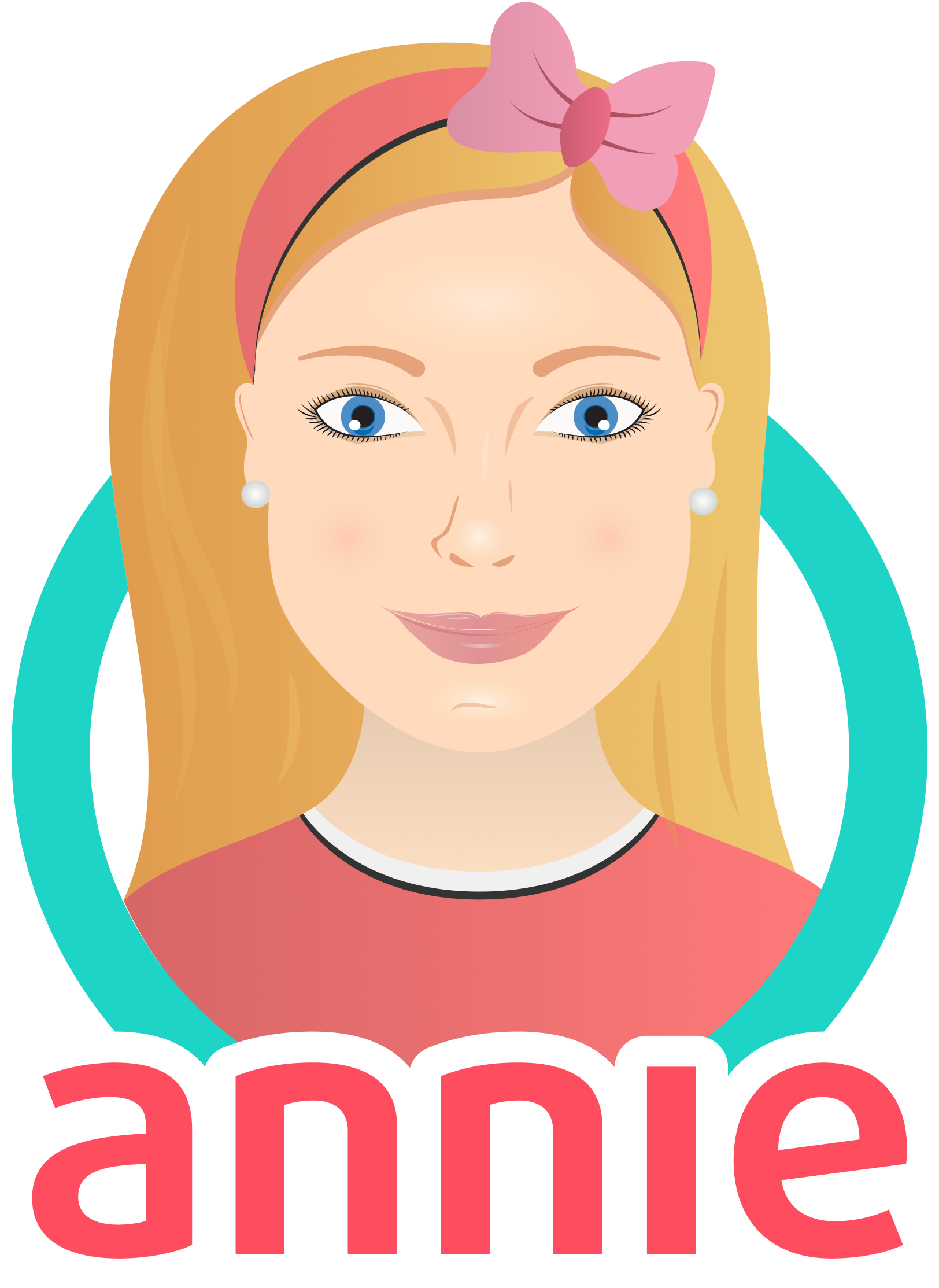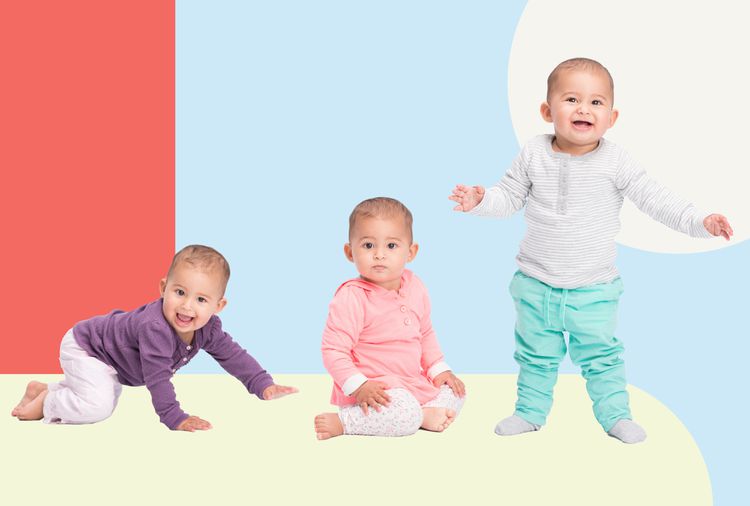
Baby Milestones By Month (Age 0-12m): Tips to Help and Guide You
- Created:
28. 5. 2024 - Updated:
2. 7. 2024
Delve into what you can expect month-by-month in your baby’s first year. From reflexes that’ll slowly fade as they grow to the skills they’ll acquire to the first steps, we’ve got it all covered.
❗Remember, every baby is unique and develops at their own pace. Some might hit milestones earlier, others later, and that’s perfectly normal.
Developmental Milestones by Month
- Your Newborn Week 1 to Week 4
- Your Baby 1 Month (Week 5 to Week 8)
- Your Baby 2 Month (Week 9 to Week 12)
- Your Baby 3 Month (Week 13 to Week 16)
- Your Baby 4 Month (Week 17 to Week 20)
- Your Baby 5 Month (Week 21 to Week 24)
- Your Baby 6 Month (Week 25 to Week 28)
- Your Baby 7 Month (Week 29 to Week 32)
- Your Baby 8 Month (Week 33 to Week 36)
- Your Baby 9 Month (Week 37 to Week 40)
- Your Baby 10 Month (Week 41 to Week 44)
- Your Baby 11 Month (Week 45 to Week 48)
- Your Baby 12 Month (Week 49 to Week 52)
In This Article Also:
- What are the developmental milestones for my baby? 👇
- When should my baby get checkups? 👇
- When and what vaccines should my baby get? 👇
- Developmental Baby Health Concerns 👇
What are the developmental milestones for my baby?
First, key to understanding your baby’s development are developmental milestones.
Developmental milestones track behaviors that mark stages of growth for your baby. Each milestone of your baby’s development focuses on four aspects of their growth including:
- Motor skills.
- Visual or problem-solving skills.
- Language development.
- Social skills.
Each baby is unique and grows at their own pace. Some babies reach milestones more quickly than their peers, while others may have slightly delayed development.
Keeping track of your baby’s progress and staying up to date on well-baby visits with your healthcare provider will ensure that your baby is developing at an average pace, or they will supervise treatment if your baby’s development is abnormal.
When should my baby get checkups?
Your baby’s first year involves regular checkups to keep an eye on their growth and development. Typically, your healthcare provider will schedule six to seven visits during this time to make sure your baby is hitting important milestones.
These checkups are super important for understanding how your baby is doing and addressing any concerns.
The visits are usually spread out over the first year:
- 1 month old
- 2 months old
- 4 months old
- 6 months old
- 9 months old
- 1 year old
During these check-ups, you can expect the following:
- Developmental milestone assessment—how your baby moves, speaks, and plays
- Physical examination and growth measurement
- Health screenings, nutrition advice, and vaccinations
- Guidance on future growth milestones
📖 Learn more about newborn birth weight: What is normal, average and low?
When and what vaccines should my baby get?
Here’s a rough timeline for the vaccines, but keep in mind that this can vary based on individual health conditions:
- Birth: Hepatitis B (first dose)
- 1-2 months: Hepatitis B (second dose)
- 2 months: Diphtheria, Tetanus, Pertussis (first dose), Polio (first dose), Pneumococcal (first dose), Haemophilus influenza type B (first dose), Rotavirus (first dose)
- 4 months: The second dose for Diphtheria, Tetanus, Pertussis, Polio, Pneumococcal, Haemophilus influenza type B, and Rotavirus
- 6 months: The third dose for Diphtheria, Tetanus, Pertussis, Polio (second dose), Pneumococcal (second dose), Haemophilus influenza type B (second dose), and Rotavirus (third dose)
- 6-18 months: Hepatitis B (third dose), Polio (third dose)
Developmental Milestones by Month
While every baby’s developmental journey is unique, knowing what to expect can help you ensure their growth is on track. Here, you can uncover the baby milestones by month that most infants usually achieve during their first year.
Newborn Baby Milestones
Newborns are still adjusting to life outside of the womb. But, they are already hitting milestones in their first month, like focusing their eyes and making new sounds.
Week 1
It’s only been a week, but your newborn already knows they can rely on you. By now, your baby can recognize your voice, and the familiarity helps them adjust to the strange new world outside the womb. Of course, they can’t understand your words, but talking to them is an expression of love and will eventually lay the foundations for language development in their brain.
Week 2
In a baby’s second week of life, your baby can focus on objects 8 to 14 inches away—about the distance between their eyes and yours during a feeding. So, as you feed your little one, move your head slowly from side to side and see if their eyes follow you. This exercise helps build their eye muscles and tracking skills.
Week 3
Though their movements are still random and jerky, your baby can start snuggling by week three. As you hold them, watch how they adjust their posture towards you. They find your arms and even your scent calming and comforting.
Week 4
Have you noticed your baby using baby’s vocal cords in ways other than crying? For example, baby may coo and make “ahh” sounds around week four, especially when they see a parent. Babies learn by mimicking, so replay their sounds back to them to promote progression through key newborn developmental milestones.
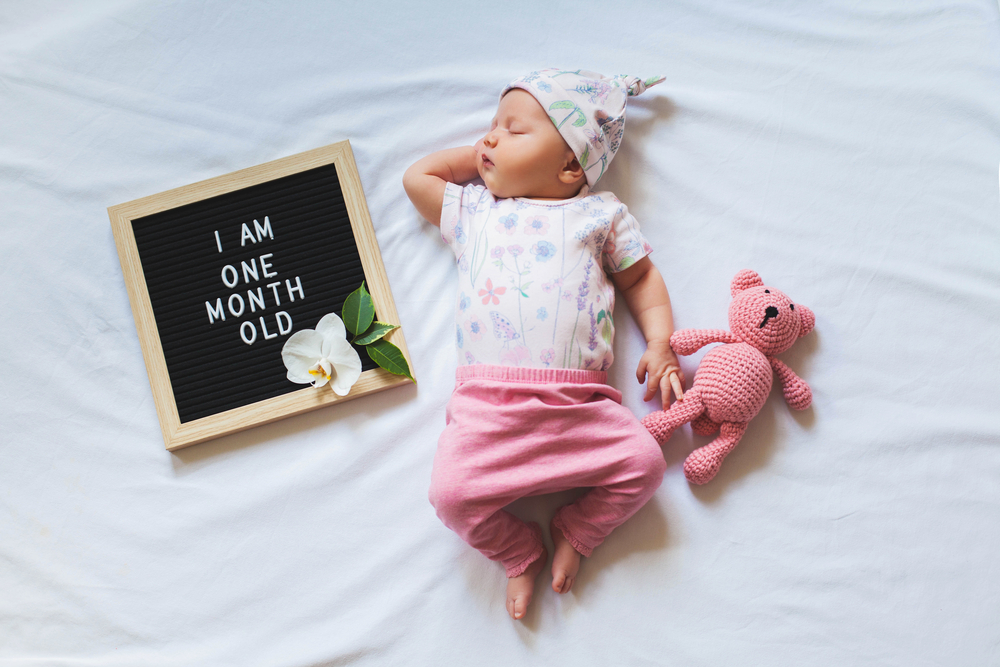
Month 1 (week 5 – 8)
- Raising their hands to their face.
- Moving their head from side to side.
- Grasping their fists tightly.
- Being alert to sounds.
- Recognizing faces.
- Eating every three to four hours on a diet of formula or breastmilk.
📖 Learn more about 1-month-old baby milestones.
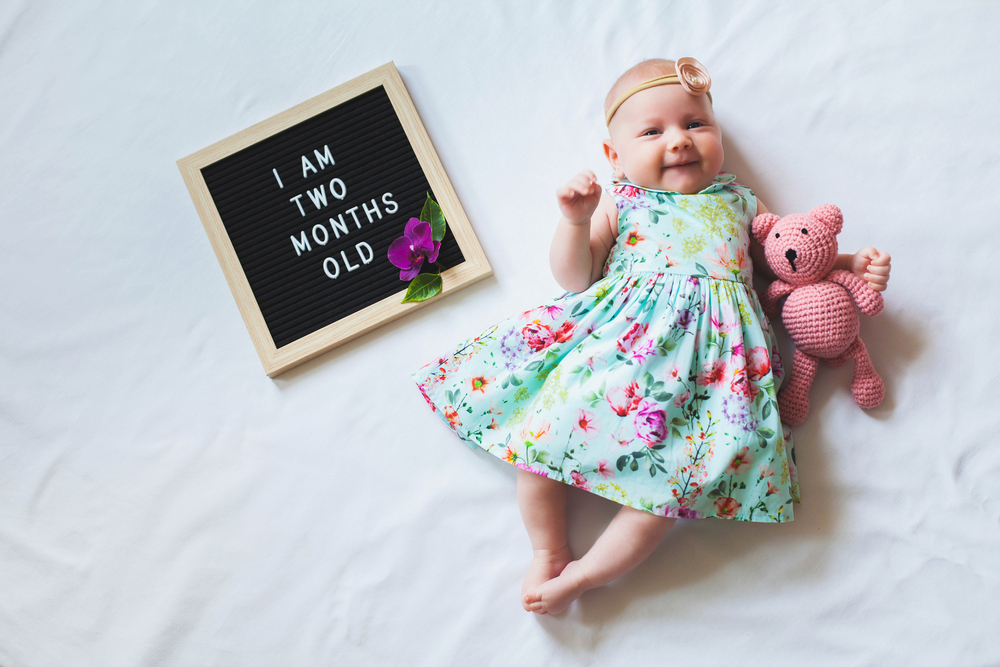
Month 2 (week 9 – 12)
- Can hold head up and begins to push up when lying on tummy.
- Makes smoother movements with arms and legs.
- Can briefly calm themselves (may bring hands to mouth to suck on).
- Coos, makes gurgling sounds.
- Begins to act bored (cries, fussy) if activity doesn’t change.
- Begins to follow things with eyes and recognize people at a distance.
- Pays attention to faces.
- Begins to smile at people.
- Turns head towards sounds and may responds to loud sounds.
- Begins to make sounds in response to others’ speech.
📖 Learn more about 2-month-old baby milestones.
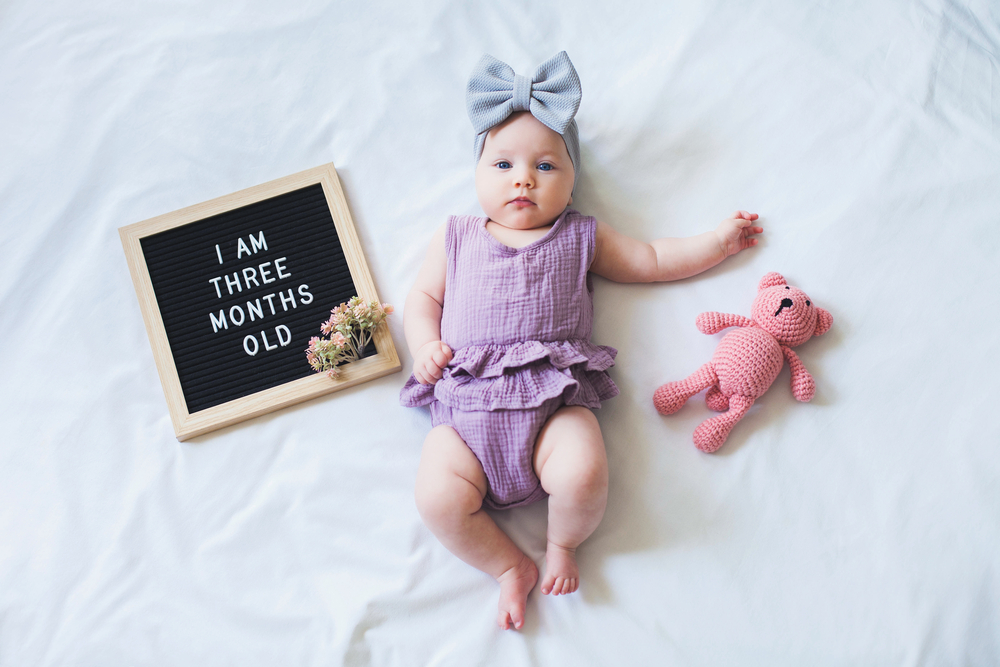
Month 3 (week 13 – 16)
- Raises head and chest when lying on stomach.
- Supports upper body with arms when lying on stomach.
- Opens and shuts hands.
- Pushes down on legs when feet are on a firm surface.
- Smiles spontaneously, especially at people.
- Enjoys playing with other people and may cry when playing stops.
- Begins to babble.
- Imitates some sounds.
- Turns head towards the direction of sound.
- Watches faces intently.
- Follows moving objects with eyes.
- Recognizes familiar people and objects at a distance.
- Starts to use hands and eyes together, such as seeing a toy and reaching for it.
📖 Learn more about 3-month-old baby milestones.
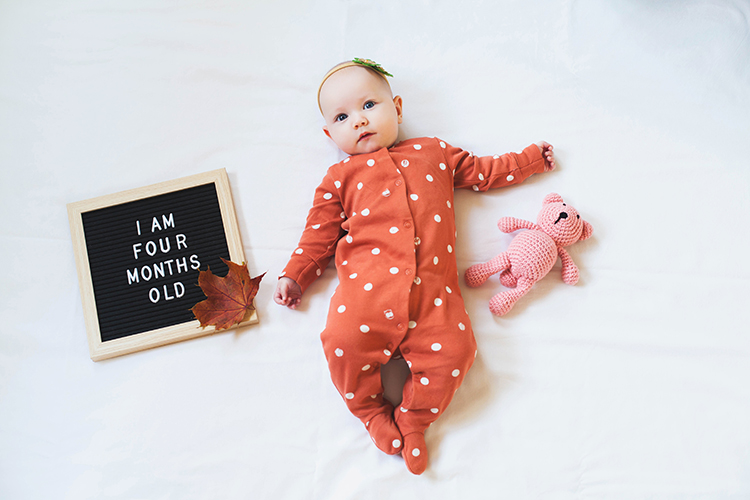
Month 4 (week 17 – 20)
- Holds head steady, unsupported.
- Pushes up to elbows when lying on stomach.
- Pushes down on legs when feet are on a hard surface.
- May be able to roll over from tummy to back.
- Brings hands to mouth.
- Uses hands and eyes together, such as seeing a toy and reaching for it.
- Reaches for toy with one hand.
- Can hold a toy and shake it and swing at dangling toys.
- Begins to babble and copies sounds he hears.
- Cries in different ways to show hunger, pain, or being tired.
- Responds to affection.
- Recognizes familiar people and things at a distance.
- Smiles spontaneously, especially at people.
- Copies some movements and facial expressions, like smiling or frowning.
- Likes to play with people and might cry when playing stops.
🍼 At 4 months, your baby might be ready to try new foods other than formula or breastmilk. An indication that your baby is ready for solid foods is when they have good head control and can turn their head away to tell you that they’ve had enough to eat.
🦷Between four to seven months you’ll notice your baby start being unusually cranky and wanting to bite down on everything in sight. That’s those new teeth coming in.
📖 Learn more about 4-month-old baby milestones.
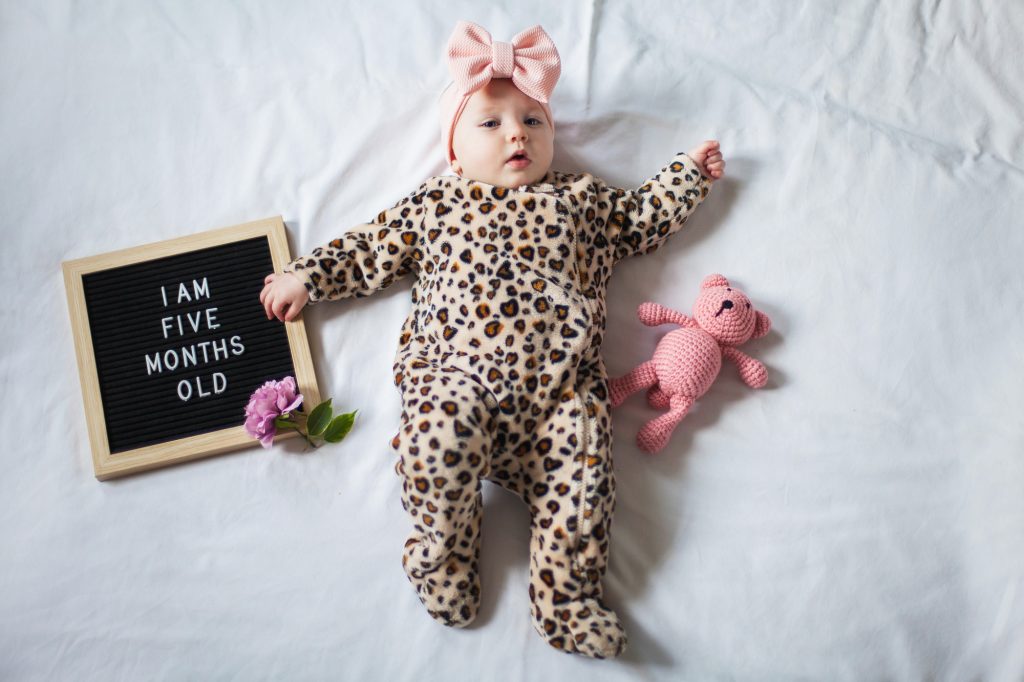
Month 5 (week 21 – 24)
- Rolls over in both directions (front to back, back to front).
- Rocks back and forth, sometimes crawling backward before moving forward.
- Begins to sit with support.
- Bears weight on legs and might bounce when standing.
- Reaches out with one hand to grasp toys.
- Grasps objects and brings them to mouth.
- Begins to transfer objects from one hand to another.
- Explores objects with hands and mouth.
- May start to show preference for certain toys.
- Recognizes familiar faces and knows if someone is a stranger.
- Responds to own name.
- Babbles and tries to imitate sounds.
- Expresses emotions like happiness, sadness, and anger more clearly.
- Responds to affection with cooing sounds and movements.
- Enjoys looking at themselves in a mirror.
📖 Learn more about 5-month-old baby milestones.

Month 6 (week 25 – 28)
- Rolls over in both directions (front to back, back to front).
- Rocks back and forth, sometimes crawling backward before moving forward.
- Begins to sit without support.
- When standing, supports weight on legs and might bounce.
- Shows curiosity and tries to get objects that are out of reach.
- Reaches with one hand, using a raking motion to grasp objects.
- Transfers objects from one hand to the other.
- Enjoys playing with toys and reaches for things out of reach.
- Begins to chew on objects.
- Starts to make consonant sounds (jabbering “m,” “b”).
- Makes sounds to show joy and displeasure.
- Begins to respond to “no”.
- Responds to own name.
- Responds to other people’s emotions and often seems happy.
- Begins to recognize familiar faces and know if someone is a stranger.
- Likes to play with others, especially parents.
- Likes to look at self in a mirror.
🍼 At 6 months, your infant is now ready for three meals of solid foods a day. A recommended example is one cereal and two servings of vegetables or fruit each day. Each meal should also include breastmilk or formula. Your baby will most likely will take another bottle in the evening. It’s normal for your baby to decrease the amount of breastmilk or formula at each feeding as their intake of other foods increases. Peel any skin from foods before giving it to your baby, as it can cause choking.
📖 Learn more about 6-month-old baby milestones.
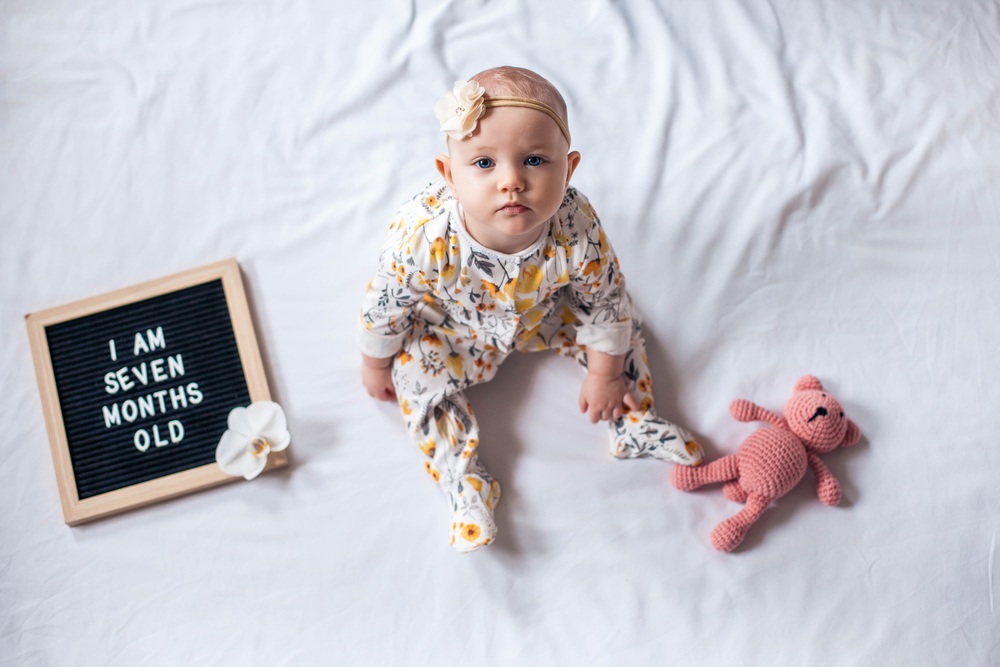
Month 7 (week 29 – 32)
- Sits without support.
- Stands with assistance and may bounce.
- Rolls over in both directions (front to back, back to front).
- Rocks back and forth, may start to crawl.
- Transfers objects from one hand to the other.
- Uses a raking motion to pick up smaller objects.
- Explores objects by shaking, banging, and throwing.
- Begins to look for objects that are partially hidden (object permanence).
- Shows curiosity by trying to get objects that are out of reach.
- Enjoys exploring different textures and shapes with hands and mouth.
- Responds to own name.
- Begins to understand “no”.
- Babbles with strings of consonants and vowels (e.g., “bababa,” “dadada”).
- Expresses more variety of emotions (joy, frustration, anger).
- Enjoys playing peek-a-boo and other interactive games.
- Shows interest in mirror images.
- Develops stranger anxiety and recognizes familiar people.
- Enjoys social play and responds to other people’s emotions.
📖 Learn more about 7-month-old baby milestones.
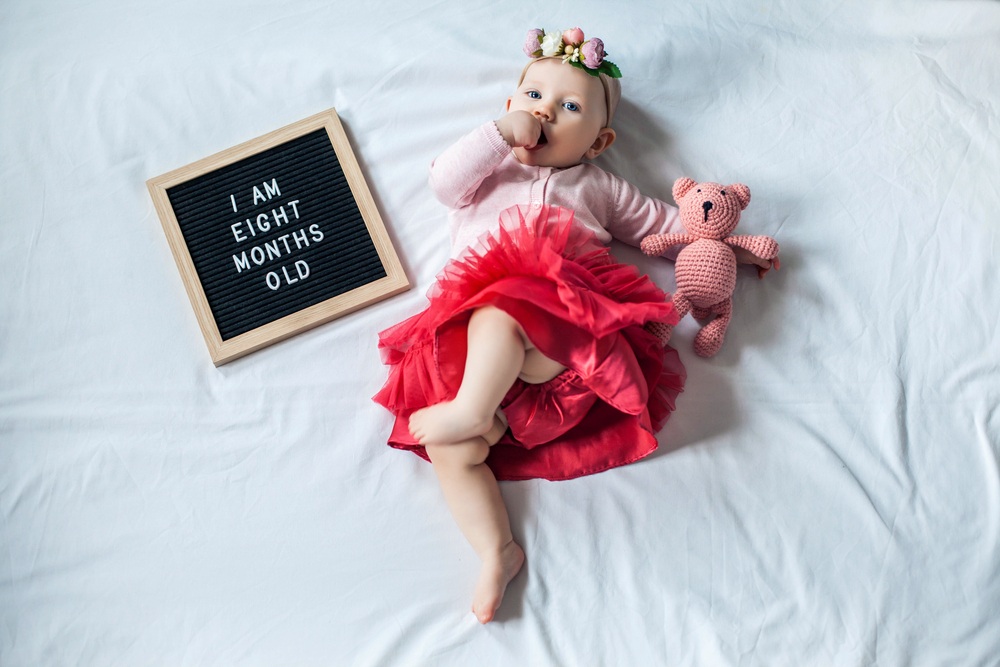
Month 8 (week 33 – 36)
- Sits without support for a long time.
- Begins to crawl or scoot on belly.
- Pulls self to standing position using furniture.
- Begins to cruise (moving while holding onto furniture).
- May start to stand briefly without support.
- Picks up small objects with thumb and forefinger (pincer grasp).
- Bangs objects together.
- Drops and throws objects intentionally.
- Responds to own name.
- Begins to understand simple words and commands.
- Babbling includes more varied sounds and may resemble speech.
- Recognizes familiar faces and objects.
- Shows preferences for certain toys or objects.
- Enjoys exploring objects in different ways (shaking, banging, mouthing).
- Begins to understand cause and effect relationships (e.g., dropping objects).
- Engages in interactive games like peek-a-boo.
- Shows interest in picture books.
- May develop separation anxiety.
- Starts to explore surroundings more actively and independently.
📖 Learn more about 8-month-old baby milestones.
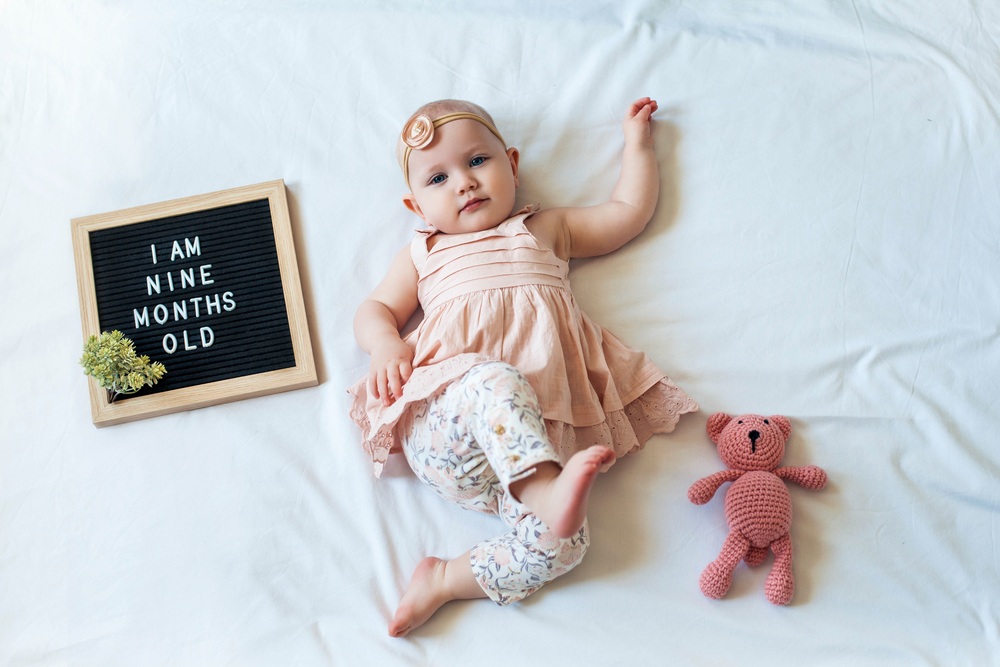
Month 9 (week 37 – 40)
- Crawls efficiently and may start to pull to stand or stand independently.
- Cruises along furniture while holding on.
- Stands momentarily without support.
- Begins to walk while holding onto furniture or with assistance.
- Sits without support for extended periods.
- Uses pincer grasp to pick up small objects.
- Bangs objects together.
- Drops and throws objects intentionally.
- Responds to own name and simple verbal commands.
- Understands some words and gestures.
- Shows curiosity and may try to imitate adult behaviors.
- Babbles strings of sounds that resemble speech.
- Shows preferences for certain toys or objects.
- Explores objects in different ways (shaking, banging, mouthing).
- Shows interest in picture books and may turn pages.
- Engages in interactive games like peek-a-boo and pat-a-cake.
- Begins to understand cause and effect relationships.
- Begins to develop a sense of object permanence (understanding that objects continue to exist even when out of sight).
- Explores surroundings more actively and independently.
🍼 By 9 months, your infant probably has a large repertoire of foods. At this age, finger foods are important. Your child can now pick up and hold small objects and shows interest in new tastes and textures of foods. Finger foods are also important as your baby strives to become more independent.
👣Some babies take their first steps as early as 9 months of their life comes, while others climb happily till 18 months of age. On average, most babies start walking between 13 and 15 months of age.
🗣️You may think you hear his first word at 9 month, but that is likely just him repeating words after you. Babies learn new languages by mimicking others, their lip movement, gestures, and tone of voice. You can help them develop these skills earlier by engaging in verbal communication with them.
📖 Learn more about 9-month-old baby milestones.
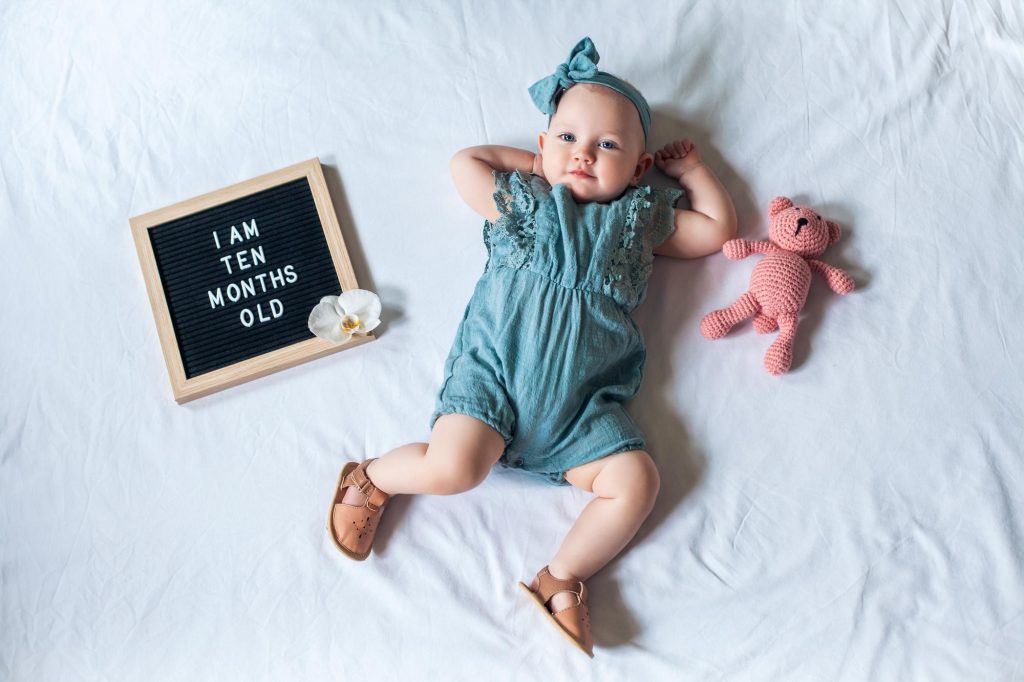
Month 10 (week 41 – 44)
- Walks while holding onto furniture or with assistance.
- May stand independently for brief moments.
- Crawls efficiently and may start to climb stairs with help.
- Pulls self to standing position easily.
- Begins to take independent steps, though may be unsteady.
- Sits without support and may prefer to sit upright rather than lying down.
- Uses pincer grasp to pick up small objects.
- Bangs objects together and enjoys dropping and throwing objects.
- Responds to own name and simple verbal commands.
- Understands some words and gestures.
- Shows curiosity and may imitate adult behaviors.
- Babbles strings of sounds that resemble speech and may mimic adult speech.
- Shows preferences for certain toys or objects.
- Explores objects in different ways (shaking, banging, mouthing).
- Shows interest in picture books and may turn pages.
- Engages in interactive games like peek-a-boo and pat-a-cake.
- Begins to understand cause and effect relationships.
- Explores surroundings more actively and independently.
- May show some signs of frustration when unable to accomplish a task.
📖 Learn more about 10-month-old baby milestones.
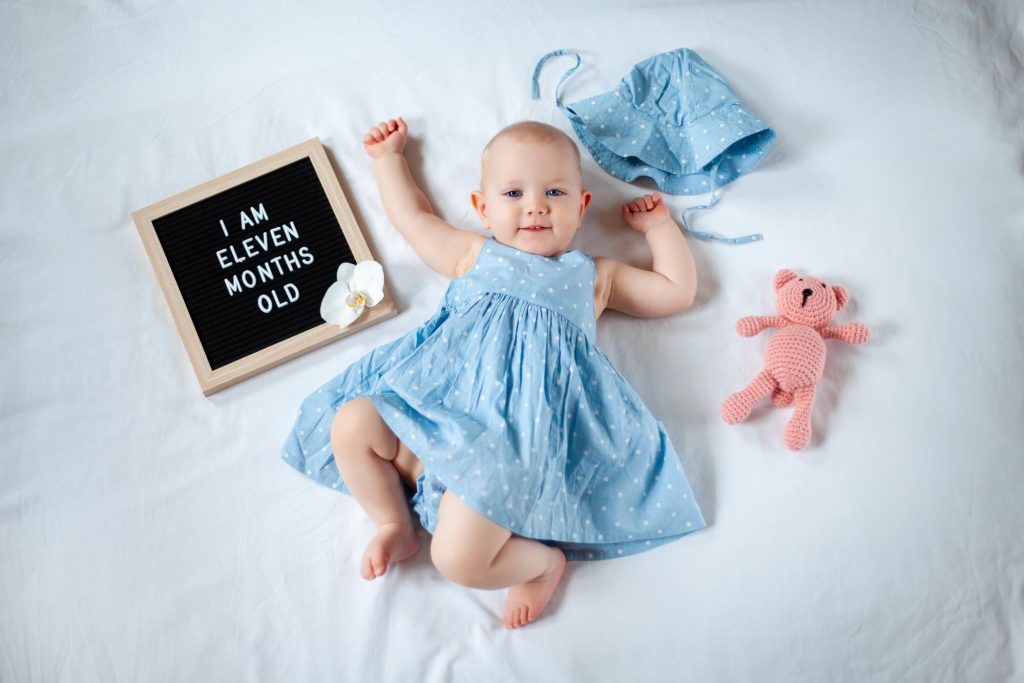
Month 11 (week 45 – 48)
- Walks with assistance or may take a few steps independently.
- Crawls efficiently and may start to climb stairs with help.
- Pulls self to standing position easily.
- May stand independently for brief moments.
- Sits without support and prefers sitting upright.
- Uses pincer grasp to pick up small objects.
- Bangs objects together and enjoys dropping and throwing objects.
- Responds to own name and simple verbal commands.
- Understands some words and gestures.
- Babbles strings of sounds that resemble speech and may mimic adult speech.
- Shows preferences for certain toys or objects.
- Explores objects in different ways (shaking, banging, mouthing).
- Shows interest in picture books and may turn pages.
- Engages in interactive games like peek-a-boo and pat-a-cake.
- Begins to understand cause and effect relationships.
- Shows curiosity and may imitate adult behaviors.
- Explores surroundings more actively and independently.
- May show some signs of frustration when unable to accomplish a task.
📖 Learn more about 11-month-old baby milestones.
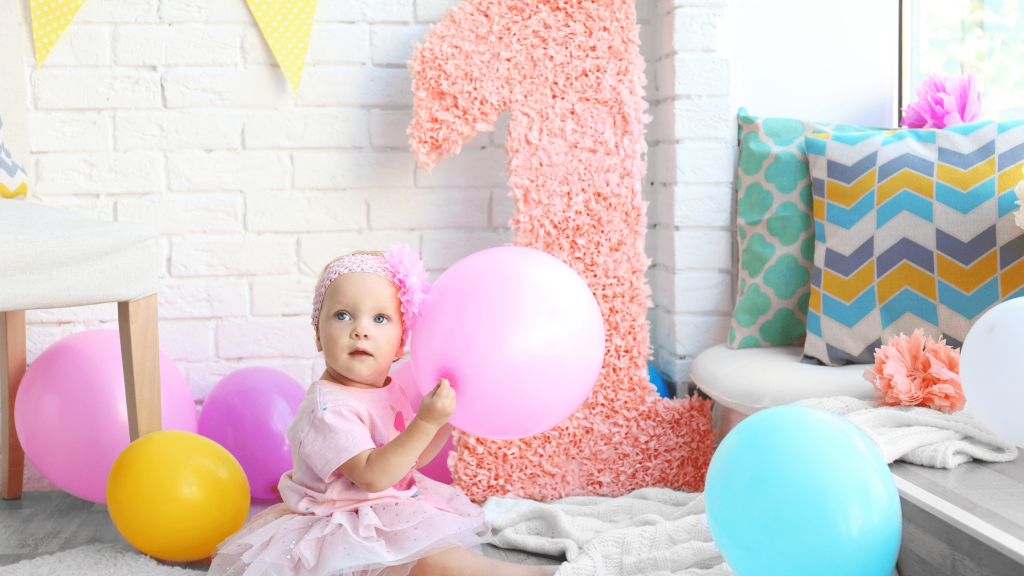
Month 12 (week 49 – 52)
- Starting to walk, standing on their own or walking by holding onto furniture.
- Holding and using objects like a crayon or a cup.
- Speaking with tone and inflection like “uh-oh!”
- Attempting to imitate words.
- Copying gestures.
🍼 By the time they are 1 year old, your child can drink whole milk instead of formula or breastmilk. Cups should begin replacing bottles. Mealtime for your baby is starting to match that of your whole family.
🗣️The real first word usually comes between 12 and 18 months. So don’t worry if your baby isn’t calling you “mama” at their 1st birthday celebration.
📖 Learn more about 12-month-old baby milestones.
Developmental Baby Health Concerns
During the first year of development, your child adjusts to the world around them. Their body may have trouble adapting comfortably. Some baby health problems might be:
Sleep regression
Period when a baby or toddler who has been sleeping well suddenly starts waking frequently at night, has trouble falling asleep, or takes shorter naps. This is typically a temporary phase and can occur due to developmental milestones, teething, growth spurts, or changes in routine. Common ages for sleep regressions are around 4 months, 8-10 months, 12 months, 18 months, and 2 years.
Constipation
Constipation means baby don’t poop often, and when do, it’s poop is hard and dry, which can make them uncomfortable and fussy. It can happen because of changes in their diet, not drinking enough fluids, or certain medical conditions. Normal baby poop is soft, wet, and runny, and can have a paste-like or seed-like texture in brown, green, or yellow colors.
Colic
Your baby may cry for extended periods that can be difficult to soothe. If your baby is extremely fussy and cries a lot, let your child’s healthcare provider know. Suggestions to calm a fussy baby include using a pacifier, rocking your baby while playing music or changing your baby’s diet.
Gass
Babies can get gassy, which can make them uncomfortable and fussy. This can happen if they swallow air while feeding, are sensitive to certain foods, or if their digestive system is still developing. You can help by burping them, giving them a gentle tummy massage, or adjusting their feeding routine. These techniques can often ease their discomfort and reduce the gas buildup.
Hiccups
They’re totally normal in babies and usually nothing to worry about. Hiccups can happen when a baby is eating and often go away on their own. They’re not a big deal unless they stick around for a long time or come with other issues.
Respiratory syncytial virus (RSV)
As your baby grows, their immune system isn’t as strong as yours, so they’re more likely to catch viruses. RSV is a common respiratory virus that a lot of kids get before they turn 2. It spreads through close contact with someone who’s infected.
Hand, foot and mouth disease
Babies can easily get hand, foot, and mouth disease, a virus that spreads through close contact and touching contaminated surfaces. This disease causes a rash and painful sores on the baby’s body, which may delay and distract them from reaching milestones.
Teething
Teething is when a baby’s first teeth start pushing through the gums. It usually begins around 6 months of age and can go on until the child is about 3 years old. Teething can make babies fussy and uncomfortable, causing symptoms like more drooling, swollen or tender gums, fussiness, and trouble sleeping or eating. These symptoms are usually temporary and can be eased with gentle care, teething toys, and sometimes over-the-counter pain relievers.
Food allergy
It means baby’s immune system mistakenly sees baby’sain food as harmful. Symptoms can vary from mild, like hives or a rash, to severe, such as trouble breathing or anaphylaxis. Common allergenic foods for babies include cow’s milk, eggs, peanuts, tree nuts, soy, wheat, fiscow’sd shellfish. If you think your baby has a food allergy, it’s important to talk to a pediatrician for help. it’stment might involve avoiding the problem food, and in serious cases, having emergency medication like epinephrine on hand.




